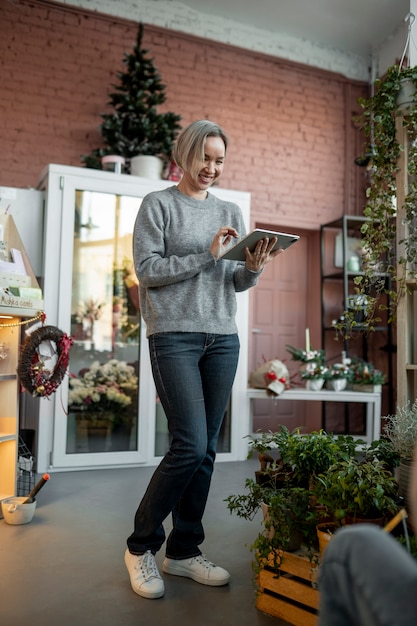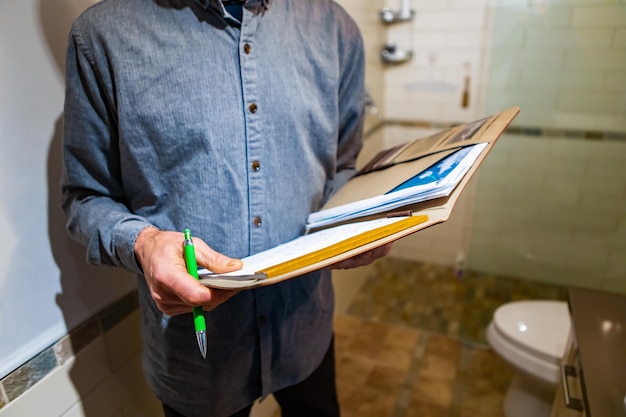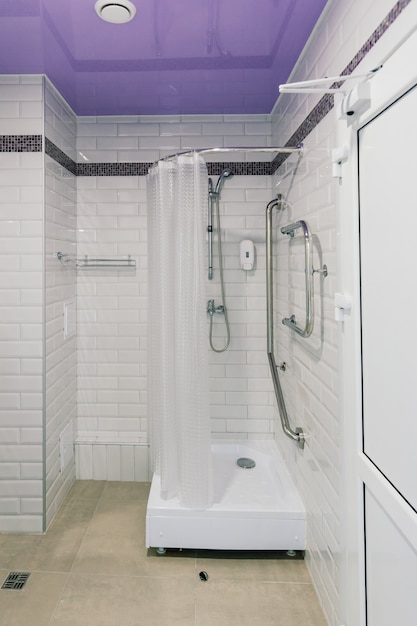Create a Safe Home: Senior-Friendly Environment for Injury Prevention

Creating a senior-friendly home environment is essential for preventing accidents and injuries by implementing modifications like grab bars, non-slip flooring, and improved lighting that cater to the specific needs and challenges faced by older adults.
Creating a safe and comfortable living space is paramount as we age, and understanding how to create a senior-friendly home environment to prevent accidents and injuries is the first step toward ensuring well-being and independence for older adults.
Understanding the Importance of Senior-Friendly Home Modifications
As individuals age, they may experience changes in mobility, vision, and cognitive function, increasing the risk of falls and other home-related accidents. By proactively modifying the home environment, families and caregivers can significantly reduce these risks, fostering independence, comfort, and a higher quality of life for seniors.
Why Home Modifications Matter
Home modifications are essential as they directly address the physical and cognitive challenges that older adults may face. These changes can range from simple adjustments like improving lighting to more complex renovations such as installing walk-in showers.
The goal is to create a space where seniors can move freely and confidently, without fear of injury. This not only promotes physical safety but also enhances emotional well-being by allowing seniors to maintain their independence and dignity.
- Reduced Fall Risk: Implementing grab bars and non-slip flooring minimizes the chance of falls, a leading cause of injury among seniors.
- Increased Independence: Accessible design features allow seniors to perform daily tasks without assistance, promoting autonomy and self-esteem.
- Improved Quality of Life: A safe and comfortable environment reduces stress and anxiety, leading to a more enjoyable and fulfilling life.
Ultimately, investing in senior-friendly home modifications is an investment in the health, happiness, and longevity of loved ones. It ensures that they can continue to live safely and comfortably in their own homes for as long as possible.
Assessing Your Home for Potential Hazards
Before making any modifications, it’s crucial to assess your home for potential hazards. This involves identifying areas where accidents are likely to occur and understanding the specific challenges faced by the senior living in the space.

Start by conducting a thorough walkthrough of each room, paying attention to factors such as floor surfaces, lighting, and accessibility. Consulting with an occupational therapist can provide expert insights and tailored recommendations.
Consider the senior’s current abilities and any existing health conditions that may impact their mobility or balance. What works now might need adjustment as their needs evolve.
Common Home Hazards to Watch Out For
Identifying common hazards is the first step in creating a safer environment. Many of these dangers are easily overlooked, but they can pose significant risks to seniors.
Some basic precautions also apply, such as minimizing clutter and ensuring that walkways are clear. These small changes can make a big difference in preventing accidents.
- Slippery Floors: Hardwood, tile, and linoleum can become slippery, especially when wet.
- Poor Lighting: Inadequate lighting can make it difficult to see obstacles and navigate safely.
- Loose Rugs: Rugs that are not properly secured can create tripping hazards.
By identifying and addressing these common hazards, you can significantly improve the safety and accessibility of your home. This thorough assessment is the foundation for making informed decisions about necessary modifications.
Bathroom Safety: Essential Modifications for Seniors
The bathroom is often the most hazardous room in the house for seniors due to slippery surfaces and limited space. Implementing specific modifications can greatly reduce the risk of falls and injuries.
Focus on installing grab bars, non-slip mats, and adjustable showerheads to make the bathroom safer and more accessible. Address each of these components thoughtfully to ensure the best possible outcome.

- Install Grab Bars: Place grab bars near the toilet and in the shower or tub to provide support and stability.
- Use Non-Slip Mats: Apply non-slip mats or adhesive strips to the floor of the shower or tub to prevent slipping.
- Install a Walk-In Shower or Tub: Consider replacing a standard tub with a walk-in model for easier access and reduced risk of falls.
These modifications not only enhance safety but also promote independence, allowing seniors to maintain their personal hygiene with confidence. Prioritizing bathroom safety is a crucial step in creating a senior-friendly home environment.
Kitchen Modifications for Safe Cooking and Accessibility
The kitchen can pose significant challenges for seniors due to the presence of sharp objects, hot surfaces, and heavy items. Modifying the kitchen to improve safety and accessibility is essential for promoting independence and preventing accidents.
Start by rearranging items to make frequently used items easily accessible. This can reduce the reaching and bending that often lead to accidents. Focus also on safety features such as automatic shut-off devices for stoves.
Practical Kitchen Modifications
Several practical modifications can transform a kitchen into a safer and more user-friendly space for seniors. These changes include adjusting counter heights, improving lighting, and installing easy-to-use appliances.
Consider options like pull-down shelving and lazy Susans to make items easier to reach. Proper planning and thoughtful implementation can make a big difference.
- Adjust Counter Heights: Lowering counter heights can make it easier for seniors to reach and use kitchen surfaces.
- Improve Lighting: Install brighter lighting, including under-cabinet lights, to enhance visibility and reduce the risk of accidents.
- Use Easy-to-Use Appliances: Replace standard appliances with models that are easier to operate, such as those with large buttons and simple controls.
These kitchen modifications can empower seniors to continue cooking and enjoying meals independently, while minimizing the risk of accidents and injuries. A well-designed kitchen is a key component of a senior-friendly home.
Improving Lighting and Visibility Throughout the Home
Adequate lighting is crucial for maintaining visibility and preventing falls, particularly as vision may decline with age. Improving lighting throughout the home is a simple yet effective way to enhance safety and comfort.
Focus on increasing the overall brightness of each room and adding task lighting in areas where specific activities take place. Consider natural light sources as well.
Strategies for Better Home Lighting
Implementing strategic lighting solutions can significantly improve visibility and reduce the risk of accidents. These strategies include layering light sources and using adjustable fixtures.
Pay attention to the color temperature of light bulbs, as warmer tones can be more comfortable and less harsh on the eyes. Additionally, consider motion-sensor lights for hallways and staircases.
- Layer Light Sources: Combine ambient, task, and accent lighting to create a well-lit and comfortable environment.
- Use Adjustable Fixtures: Install adjustable light fixtures to direct light where it’s needed most.
- Consider Motion-Sensor Lights: Place motion-sensor lights in hallways and staircases to automatically illuminate the path.
By optimizing lighting throughout the home, you can create a safer and more welcoming environment for seniors, reducing the risk of falls and enhancing their overall quality of life. Good lighting is an essential element of a senior-friendly home.
Flooring and Stairway Safety: Preventing Falls
Flooring and stairways present common fall hazards for seniors. Modifying these areas to improve traction and stability is crucial for preventing accidents and ensuring safe mobility.
Focus on installing non-slip flooring throughout the home and adding handrails to stairways. These changes can make a significant difference in reducing the risk of falls.
Simple Steps for Flooring and Stairway Safety
Several simple steps can be taken to enhance the safety of flooring and stairways. These include securing rugs, installing non-slip treads, and improving lighting on staircases.
Consider also the use of contrasting colors to make steps more visible and easier to navigate. Attention to these details can greatly improve safety.
- Secure Rugs: Use rug pads or adhesive tape to secure rugs and prevent them from sliding.
- Install Non-Slip Treads: Apply non-slip treads to stairways to provide better traction and reduce the risk of slips.
- Improve Stairway Lighting: Ensure stairways are well-lit with both overhead and step lighting.
By addressing flooring and stairway safety, you can create a more secure and accessible home for seniors, minimizing the risk of falls and promoting their overall well-being. A safe home is a happy home.
| Key Point | Brief Description |
|---|---|
| 💡 Improved Lighting | Enhance visibility with brighter lights and motion sensors. |
| 🛁 Bathroom Safety | Install grab bars, non-slip mats, and walk-in showers. |
| 🍴 Kitchen Accessibility | Adjust counter heights and use easy-to-reach appliances. |
| 🚷 Fall Prevention | Secure rugs and add handrails to stairways. |
Frequently Asked Questions
▼
Key modifications include improving lighting, installing grab bars in bathrooms, non-slip flooring, and ensuring clear pathways to reduce fall risks and enhance mobility for older adults.
▼
Install grab bars near the toilet and in the shower, use non-slip mats, consider a walk-in shower, and ensure adequate lighting to minimize the risk of slips and falls.
▼
Rearrange items for easy access, lower counter heights if needed, use appliances with simple controls, and improve lighting to make cooking and meal preparation safer and more convenient.
▼
Add brighter overhead lights, use task lighting in specific areas, install motion-sensor lights in hallways and staircases, and ensure no dark corners to enhance visibility and reduce fall risks.
▼
Non-slip flooring like rubber, cork, or textured tile is ideal. Secure rugs with padding or tape, and ensure stairways have non-slip treads and adequate lighting to minimize slip and fall hazards.
Conclusion
Creating a senior-friendly home environment is a proactive and compassionate approach to ensuring the safety, independence, and well-being of older adults. By implementing thoughtful modifications and addressing potential hazards, families can provide a comfortable and secure living space that promotes a higher quality of life for their loved ones. The investment in these changes is an investment in their continued health and happiness.
